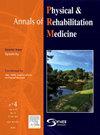Nitrous oxide analgesia for rehabilitation after anterior cruciate ligament reconstruction: A randomized controlled trial
IF 4.6
3区 医学
Q1 REHABILITATION
Annals of Physical and Rehabilitation Medicine
Pub Date : 2025-01-10
DOI:10.1016/j.rehab.2024.101897
引用次数: 0
Abstract
Background
Although there is increasing emphasis on rehabilitation training after ligament reconstruction, little is known about the pain induced by the procedure itself. Procedural success may be limited by pain and anxiety. Nitrous oxide is widely used to alleviate procedural pain. However, few studies have been conducted to show the efficacy and safety of nitrous oxide for rehabilitation training.
Objectives
To explore the short-term efficacy and safety of nitrous oxide for acute pain elicited by rehabilitation training.
Methods
A double-blinded randomized placebo-controlled trial was conducted in the department of rehabilitation medicine. People willing to participate in the trial and sign informed consent, ≥18 years old, who had acute pain (self-reported pain score ≥4) caused by rehabilitation training after anterior cruciate ligament reconstruction were recruited. Participants undergoing rehabilitation training were randomized to receive either 65 % nitrous oxide or 100 % oxygen. The primary outcome was the pain score. Secondary outcomes were sedation score, range of motion, vital signs, physician and participant satisfaction, acceptance, and side effects.
Results
120 people were enrolled; 60 received nitrous oxide and 60 received oxygen. The nitrous oxide group had a significantly lower pain score than the placebo group (P < 0.001, median difference -3, 95 % CI -4 to -2, effect size η2 = 0.369) and sedation scores (P < 0.001, median difference 1, 95 % CI 1 to 1, η2 = 0.263) during the procedure. Both physician (P < 0.001) and participant (P < 0.001) satisfaction were significantly higher in the intervention group than the placebo group. Acceptance (willingness to use the same gas next time) differed between groups (P < 0.001). No serious side effects occurred.
Conclusion
This study provides evidence supporting the efficacy and safety of self-administered nitrous oxide to reduce procedural pain during rehabilitation training after anterior cruciate ligament reconstruction.
一氧化二氮镇痛用于前交叉韧带重建后的康复:一项随机对照试验。
背景:虽然人们越来越重视韧带重建后的康复训练,但对手术本身引起的疼痛知之甚少。手术的成功可能受到疼痛和焦虑的限制。一氧化二氮被广泛用于减轻程序性疼痛。然而,很少有研究表明氧化亚氮用于康复训练的有效性和安全性。目的:探讨氧化亚氮治疗康复训练引起的急性疼痛的近期疗效和安全性。方法:在康复内科进行双盲随机安慰剂对照试验。招募愿意参加试验并签署知情同意书的患者,年龄≥18岁,前交叉韧带重建后因康复训练引起急性疼痛(自述疼痛评分≥4分)。接受康复训练的参与者随机接受65%的氧化亚氮或100%的氧气。主要结果是疼痛评分。次要结局是镇静评分、活动范围、生命体征、医生和参与者满意度、接受度和副作用。结果:入组120人;60人接受氧化亚氮,60人接受氧气。在手术过程中,氧化亚氮组的疼痛评分明显低于安慰剂组(P < 0.001,中位数差值-3,95% CI -4 ~ -2,效应大小η2 = 0.369)和镇静评分(P < 0.001,中位数差值1,95% CI 1 ~ 1, η2 = 0.263)。干预组的医师满意度(P < 0.001)和参与者满意度(P < 0.001)均显著高于安慰剂组。接受度(下次使用相同气体的意愿)在两组之间存在差异(P < 0.001)。没有发生严重的副作用。结论:本研究支持自体氧化亚氮减少前交叉韧带重建术后康复训练过程疼痛的有效性和安全性。
本文章由计算机程序翻译,如有差异,请以英文原文为准。
求助全文
约1分钟内获得全文
求助全文
来源期刊

Annals of Physical and Rehabilitation Medicine
Medicine-Rehabilitation
CiteScore
7.80
自引率
4.30%
发文量
136
审稿时长
34 days
期刊介绍:
Annals of Physical and Rehabilitation Medicine covers all areas of Rehabilitation and Physical Medicine; such as: methods of evaluation of motor, sensory, cognitive and visceral impairments; acute and chronic musculoskeletal disorders and pain; disabilities in adult and children ; processes of rehabilitation in orthopaedic, rhumatological, neurological, cardiovascular, pulmonary and urological diseases.
 求助内容:
求助内容: 应助结果提醒方式:
应助结果提醒方式:


